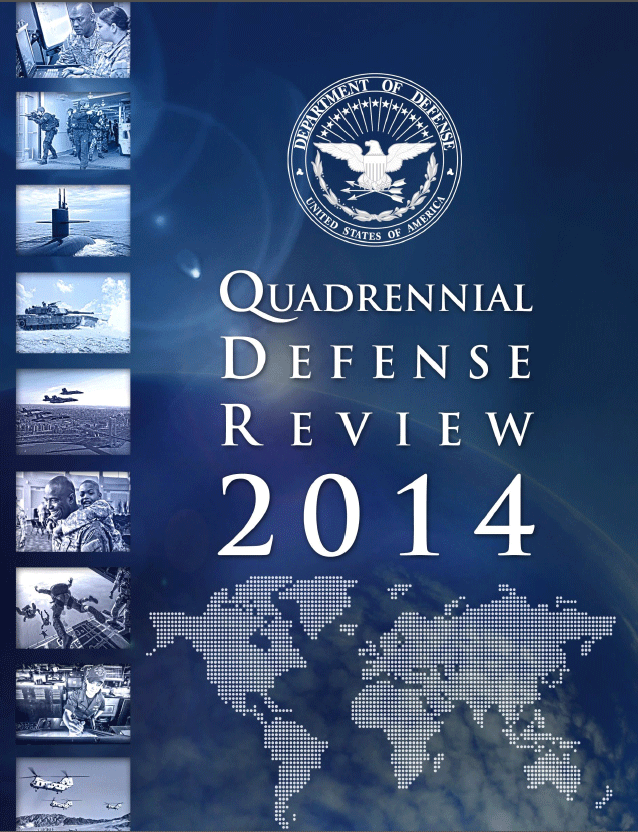I commented last week on my expectations concerning the QDR and I wasn’t disappointed  when I got around to reading it yesterday. After reading it through a couple of times (available here), I was still pretty much confused about what it was trying to say. And it didn’t look much like a strategy document to me…mostly filled with budget numbers and reasons why we couldn’t do this or that because of it. In the end, it’s definitely a document very much “informed” by the realities of the budget. I came away with the impression that it was less about strategy and more about money, especially given the frequent references to budget woes. I stand by my comments in the recent Q•D•Arrggghh article about the difference between “constrained” and “informed. I can’t tell the difference, nor apparently, can the authors of this tome. It was pretty much more of the same from the last QDR…….nothing jumped out at me.
when I got around to reading it yesterday. After reading it through a couple of times (available here), I was still pretty much confused about what it was trying to say. And it didn’t look much like a strategy document to me…mostly filled with budget numbers and reasons why we couldn’t do this or that because of it. In the end, it’s definitely a document very much “informed” by the realities of the budget. I came away with the impression that it was less about strategy and more about money, especially given the frequent references to budget woes. I stand by my comments in the recent Q•D•Arrggghh article about the difference between “constrained” and “informed. I can’t tell the difference, nor apparently, can the authors of this tome. It was pretty much more of the same from the last QDR…….nothing jumped out at me.
For fun, I wrote down a few of “Pentagonisms” from the Executive Summary which I thought I would share along with a short definition in normal-speak:
- New Presence Paradigm: Overseas Bases
- Hybrid Contingencies: Kludges
- Proxy Groups: Terrorists
- Dynamic Environment: The Real World
- Asymmetric Approaches: More with less
- Rebalance Tooth-to-Tail: Cut contractors
- Win Decisively: Win
- Rebalance: Cut
- “Opportunity, Growth, and Security” Initiative: Slush Fund
- Innovation: Not in DoD dictionary
- Multi-lateral Security Architecture: Treaty
- Force Planning Construct: Size
- Efficiencies: Negative Budget Wedges
Well, I grow weary of writing them down. I’ll say one thing for the document….It’s a Presbyterian minister’s dream. Presbyterians are well know for their penchant for ORDER, ORDER, ORDER!!!! Sermons are typically organized into three points with two or more sub-points and a healthy dose of references to Bonhoeffer and Kierkegaard. My favorite Kierkegaard quote is “People demand freedom of speech as a compensation for freedom of thought, which they seldom use.” As I read through it, I was trying to capture the taxonomy of thought. Let’s see, we have 3 Strategic Pillars, 4 Core National Interests, 4 Strategic Imperatives, 3 Areas of Risk, etc. And they are all interrelated and interdependent! I can’t keep it all straight.
Anyway, the QDR is out and we can all tune back into Duck Dynasty, The Voice, or whatever other twisted view of reality you may retreat into every night. And why is all this Energy stuff in there? Since when is the DoD the EPA? (Sorry for the random comment but I just had to get it of my chest!) Perhaps the best part of the whole schmegegge is the Chairman’s Assessment at the end. At least he puts out a list to which I can relate. In the end what does it all mean and what are our real priorities? According to the plain language of General Dempsey:
- The survival of the Nation
- The prevention of catastrophic attack against U.S. territory
- The security of the global economic system
- The security, confidence, and reliability of our allies
- The protection of American citizens abroad
- The preservation and extension of universal values.
AMEN
(Why didn’t we say that in the beginning and omit the other 63 pages?)

